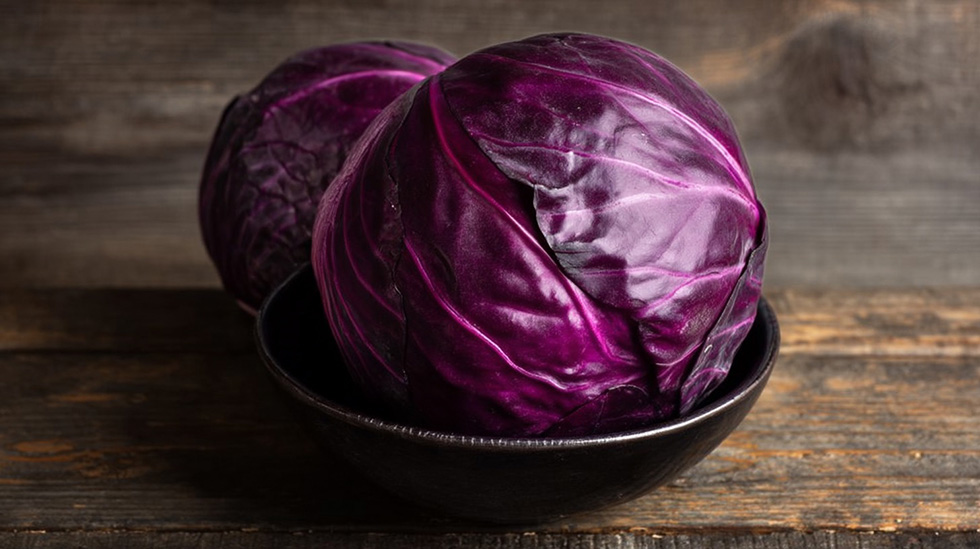Meet the red cabbage – a colourful vitamin bomb! 🥬💜
Red cabbage is a colourful variety of cabbage. It is also known as Brassica oleracea var. capitata f. rubra . It is also closely related to cabbage, broccoli, cauliflower and kale, as they all belong to the crucifer family.

Its origins go back to the ancient Mediterranean: it was known and consumed by the ancient Greeks and Romans. However, its purple colour only became widespread around the Middle Ages, when more pigment-rich varieties were cultivated.
3. How important is it in the kitchen?
Evaluation: 4/5
Red cabbage is a staple in Hungarian and many European cuisines. Although it is not a common household staple, it can be used as a pickle, a main dish, a salad or a side dish. It is a regular at festive tables, especially with roasts.
4. Which part of the plant is edible?
The most edible part of the red cabbage is the head – the leaves – which are solid and purplish red in colour. The leaves are delicious both raw and cooked. The outer, hardened or damaged leaves should be removed.
Non-edible parts:
- Torsos – hard, fibrous and difficult to digest
- The root – not edible and not used in any form
5. Health benefits and nutritional content
Not only is red cabbage an eye-catcher, it’s also a health bomb:
- Rich in vitamin C – supports the immune system
- Excellent source of fibre – aids digestion
- Contains vitamin K – beneficial for bones and blood clotting
- High in anthocyanins – these pigments have antioxidant properties and can help protect against cell damage
Traditional folk medicine also counts it as an anti-inflammatory and digestive aid, and it is also believed to help regulate blood sugar levels.
6. Specificities of its production
Red cabbage is a field-grown crop, usually in season from July to the end of November. It prefers cooler climates and is mainly grown in large quantities in central and northern Europe. Germany, the Netherlands and Poland are among the largest producers.
It is also cultivated in Hungary, especially between the Danube and the Tisza, and in the Transdanubian region. You are most likely to see Hungarian cabbage on the shelves in autumn and winter. In spring and summer, imported varieties, mainly of Spanish or Dutch origin, are more common on the shelves.
7. How to choose good quality cabbage?
Consider these aspects when shopping:
- The head should be hard and firm to the touch – if it is soft, it is already wilted
- The leaves should be bright, bright purple, not pale
- Avoid cracked, browned, damaged or drying specimens
A good kale is surprisingly heavy for its size, another sign of freshness.
8. How do we store it at home?
It’s best to store the red cabbage in the bottom vegetable drawer of the fridge, wrapped in loose paper or kitchen towels. This will keep it fresh for up to 2-3 weeks. It’s important not to wash it in advance, but just before use.
If you’ve only cut off a piece of the head, foil the remaining part and use it as soon as possible – the cut surface will deteriorate faster.
9. Red cabbage in the kitchens of the world
Cauliflower is a popular vegetable all over the world:
- Germany: an essential part of the famous Rotkohl (sweet and sour stewed cabbage)
- Scandinavian countries: a common accompaniment to fish and game dishes
- USA: coleslaw (American coleslaw) is also made with cabbage
- Asia: it also goes into colourful salads and wok dishes
10. A classic recipe: steamed red cabbage with apples 🍎
This dish is the perfect accompaniment to a good roast or even a vegetarian meatloaf.
Ingredients:
- 1 head of red cabbage
- 1 medium onion
- 2 apples (sour apples)
- 2 tablespoons of sugar
- 1 tablespoon vinegar (apple or wine vinegar)
- salt, pepper, cumin seeds
Preparation: thinly slice the cabbage, grate the apple and sauté everything together in a little fat. Season with seasoning, vinegar and sugar. Cook over a slow fire for 25-30 minutes until perfectly tender.
11. How do we use red cabbage in the kitchen?
This vegetable is a great vegetable to vary:
- Raw: grated or thinly sliced for salads, sandwiches
- Steamed: a classic side dish with meat
- Grilled: a fantastic vegan dish with a little olive oil and spices
- As a smoothie: with apple, beetroot, ginger – only for the brave! 😄
What spices go with it?
- caraway seeds
- pepper
- cloves
- bay leaf
- almaecet
What to avoid:
- basil – suppresses the taste of cabbage
- rosemary – too dominant, not suitable for this vegetable
Summary
As well as being beautiful and healthy, red cabbage is a really versatile vegetable. If you’ve only had it on your table at Christmas, now’s the time to try it more often – especially as it keeps well in the fridge! 😉
